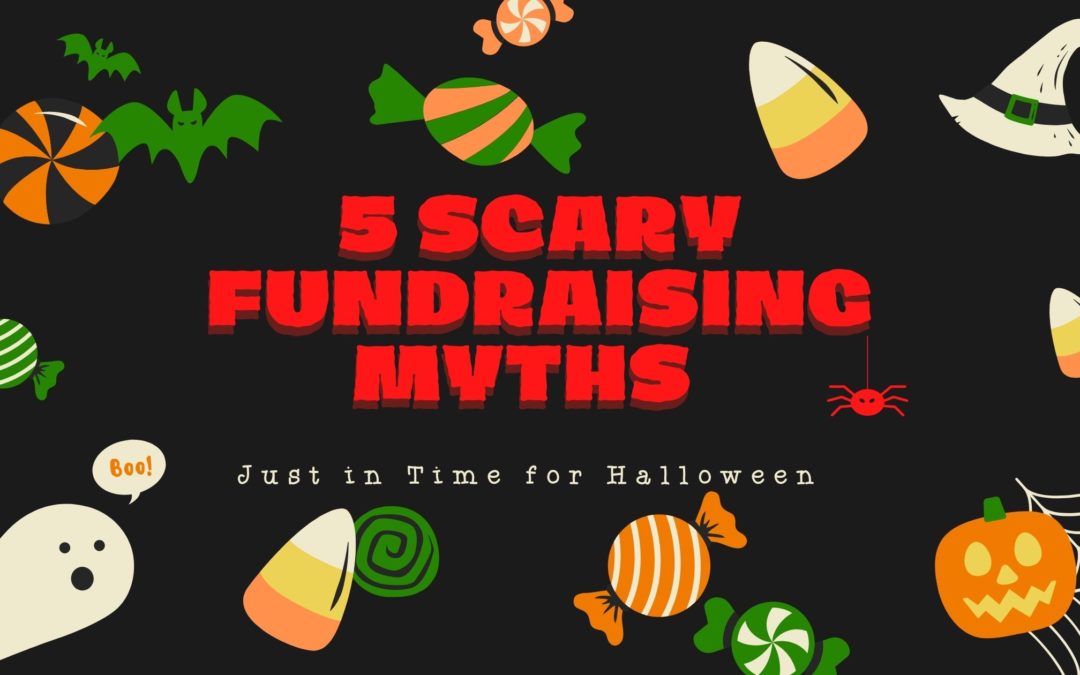It’s that time of year. The ghouls and goblins come out to play and not the costume-clad ones. I have heard these scary fundraising myths so many times in the last month that I wanted to address them in this Halloween edition of The Nonprofit Insiders Club.
Understanding these myths will help you raise more money and avoid falling into their traps.
The Donor Fatigue Monster Myth
I hear nonprofit leaders- from boards to staff- regurgitate this myth. They think that asking for money will make a donor mad and never give again. The proposed way to deal with “donor fatigue” goes like this:
- Let’s discuss what’s wrong with donors in general.
- We will just go silent so we don’t disturb our fragile donors.
- It’s not our fault we didn’t raise money, it’s our donors! They wouldn’t/couldn’t give.
The truth is that the donor who just gave is twice as likely to give again soon after giving. People want to help. It’s that simple. The organizations that don’t want to ask their donors tend to blame their donors. I find that donations decline when organizations don’t do any of the following:
- Segment their list.
Segmenting your list will help you not ask the same people over and over if you are worried about that. I knew an organization whose service area was one county. They sent out four appeals a year and to save money they divided the county up into four quadrants. Each appeal was sent to one quadrant at a time and rotated each year. So, quadrant 1 received the spring appeal the first year and then the summer appeal the second and so on. I would also segment out those new donors in your welcome email sequence. Let them get acquainted with your organization before you ask for money.
- Ask for money for a need that means something to the donor.
The most common reason I see that people don’t give is that the ask wasn’t compelling. Organizations don’t connect the mission to the ask. They don’t write heart-tugging copy or choose images that connect to the donor. These things must be in any ask to be successful.
- Thank and provide impacts in between asks.
Many organizations only ask. They don’t communicate the best parts of donating to the organization- the thank you and the impact the donation had on a person’s (or animal’s) life. Sending newsletters, emails, or social media posts that express gratitude and impact greatly increase donations when donors are asked.
“I Played an Expert on TV” Fundraising Theories Myth
Listening to these dress-up fundraising “experts” only kills your fundraising. I call them theories because the data and experience of true professionals don’t back the theories up. Here are the theories I’m talking about.
- Direct mail doesn’t work anymore.
I’ve heard this over and over but the number of organizations that raise money (especially in the pandemic) with direct mail doesn’t support this theory. Putting the work into an appeal is worth the effort.
- Grants will completely fund us.
Unfortunately, I see this from either desperate organizations or grant writers trying to land a client. They promise the very new nonprofit can get funding from grants or the more established nonprofit won’t have to worry about other fundraising activities because they can get millions of dollars in a few grants. It just isn’t true. You have to be grant ready, write a powerful proposal, and maybe you will be funded. It will take 3-6 months to know and if you get the grant, it will take time and resources to collect the data needed to report back to the funder.
- We need a fundraiser next month because we need money.
And by fundraiser, they usually mean an event. This is a terrible way to plan events. They need time and attention to plan and execute well. A well planned fundraising plan will be so much more effective than the event hamster wheel.
The Committee Loves This Zombie Myth
But does your donor? It doesn’t matter if we are talking about fundraising letters or events. If it doesn’t appeal to your donor, then it doesn’t matter. The committee changes and usually just kill the fundraising campaign only to have to be resurrected in a doomed attempt to raise money.
Donors Are Terrifying Vampire Myth
Talking to them and asking their opinion will make them angry, they’ll quit donating, and never come back. Getting their opinion opens up a can of worms. It seems donors just suck these organizations dry. The thing is- talking to your donors does just the opposite. It makes them more invested in your cause and you get valuable insights that help you make fundraising activities even more effective. Talking to donors can breathe new life into raising money if you let it.
Partnering with Other Organizations is Doomed
Not all partnerships are created equal but when everyone is on the same page, it can be a very good thing. Partnering with an organization for a grant or for a long-term solution can work well. The keys are to have the agreement in writing spelling out what both sides will be responsible for; great communication; and knowing that it isn’t forever. Things change. Needs change. It’s okay. Build a relationship that is transparent and honest with each other.
Happy Halloween everyone! Stay safe out there.


 Most nonprofit leaders lay awake at night trying to figure out how to fund their mission.
Hi! I'm Alesha.
I teach sustainable fundraising in a way that they can take action today so they can serve their clients.
I can help you move from just getting started funding your new nonprofit to gaining confidence in your fundraising and building relationships to knowing what works for your organization and looking at the infinite game when it comes to funding. I’ve worked with nonprofit Founders and written the book I HAVE MY 501(C)3! NOW WHAT?!? Your Blueprint to Starting Your Nonprofit Without Being the Sole Funder that lays the foundations for funding in a new nonprofit.
I’ve worked in Development (Fundraising) Departments in large organizations and I know the no cost, low-cost methods they use to bring in funding. I bring those sound strategies to the nonprofits I serve.
Most nonprofit leaders lay awake at night trying to figure out how to fund their mission.
Hi! I'm Alesha.
I teach sustainable fundraising in a way that they can take action today so they can serve their clients.
I can help you move from just getting started funding your new nonprofit to gaining confidence in your fundraising and building relationships to knowing what works for your organization and looking at the infinite game when it comes to funding. I’ve worked with nonprofit Founders and written the book I HAVE MY 501(C)3! NOW WHAT?!? Your Blueprint to Starting Your Nonprofit Without Being the Sole Funder that lays the foundations for funding in a new nonprofit.
I’ve worked in Development (Fundraising) Departments in large organizations and I know the no cost, low-cost methods they use to bring in funding. I bring those sound strategies to the nonprofits I serve.